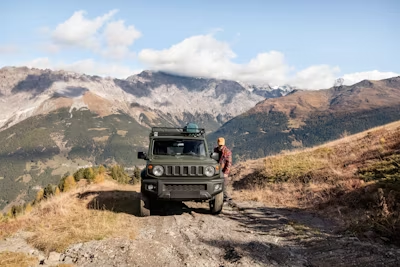In a world of increasingly homogenized transportation, where crossover SUVs blend into an indistinguishable sea of aerodynamic sameness, one vehicle stands defiantly apart. With its iconic seven-slot grille, round headlights, and a silhouette as recognizable as the skyline of Manhattan, the Jeep Wrangler is not just a mode of transport; it is a statement. It is a rolling testament to a simpler time, a mechanical promise of freedom, and an unbreakable thread connecting the battlefields of World War II to the rocky trails of Moab and the sun-drenched beaches of today. The Wrangler is an anomaly, a vehicle that prioritizes capability over comfort, character over convenience, and the call of the wild over the quiet hum of the highway. This is the story of its enduring, unbreakable allure.
From War Horse to Plaything: A Legacy Forged in Steel
To understand the Wrangler is to acknowledge its profound debt to the past. Its direct ancestor, the Willys MB, was the hero of the Second World War. Designed to be simple, rugged, and utterly reliable, it was a tool for victory, ferrying soldiers and supplies through terrain that would stop any other vehicle. When the war ended, the GIs who had depended on these rugged machines brought their affection home with them. The civilian version, the CJ (for “Civilian Jeep”), was born, transitioning the workhorse into a tool for farmers, ranchers, and a new generation of outdoors enthusiasts.
The Wrangler nameplate itself debuted in 1986 (as the YJ generation), but it was merely an evolution of the CJ-7. While purists initially balked at its square headlights, the spirit remained intact. It was a bare-bones, open-air, go-anywhere vehicle. Subsequent generations—the TJ (with the triumphant return of round headlights) in 1996, the more refined but still rugged JK in 2006, and the current JL in 2018—have each refined the formula without ever diluting its core identity. The Wrangler has managed to evolve, acquiring modern safety features, improved engines, and tech-laden interiors, all while keeping its soul firmly intact.
The Anatomy of Capability: Why It Dominates Off-Road
The Wrangler’s reputation isn’t built on nostalgia alone; it’s engineered into its very DNA. While most modern SUVs are built on car-based unibody platforms for a smoother ride, the Wrangler retains a separate body-on-frame construction. This is the same method used by heavy-duty trucks, providing an incredibly strong and rigid foundation that can withstand the immense twisting forces of off-road driving.
Then there are the axles. The Wrangler uses solid front and rear axles, a design largely abandoned by the automotive industry for on-road use. While independent suspension offers a plusher ride on pavement, a solid axle ensures that when one wheel is articulating over a boulder, the opposite wheel maintains better contact with the ground. This is fundamental to traction in extreme conditions.
This mechanical prowess is activated by a suite of purpose-built features. High ground clearance is a given. A short wheelbase allows it to navigate tight, winding trails and tackle steep inclines without scraping its undercarriage. Advanced four-wheel-drive systems, often with a robust two-speed transfer case, provide both high-range for slippery roads and low-range for crawling over obstacles at a snail’s pace with immense torque.
But perhaps the most critical element is its approach, breakover, and departure angles. These are the angles that determine how steep a hill it can climb, how sharp a crest it can traverse, and how steep a descent it can manage without its bumpers or chassis hitting the ground. The Wrangler is designed with these angles maximized, giving it a geometric advantage that few vehicles can match. It is, quite simply, a mountain goat in a world of sheep.
The Open-Air Freedom: The Wrangler’s True Soul
While its off-road prowess is legendary, the Wrangler’s most intoxicating feature is one that requires no technical expertise to appreciate: its open-air freedom. In an age where sunroofs are measured in inches, the Wrangler offers a connection to the environment that is almost unparalleled.
The process is part of the ritual. The simple, latched doors can be unbolted and removed entirely. The lightweight, frameless windows can be unzipped and stowed away. And the roof—whether the standard soft top or the optional hardtop—can be folded back or taken off completely. The result is a driving experience that is visceral and immediate. You feel the sun on your skin, the wind in your hair, and the sounds and smells of the world around you. A drive to the grocery store can feel like a safari, and a coastal road becomes a cinematic event.
This transformable nature fosters a unique relationship between the driver and the journey. It encourages spontaneity, urging you to take the long way home, to stop and watch the sunset, or to simply sit parked and stare at the stars. This isn’t a feature that can be quantified on a spec sheet, but it is the very essence of the Wrangler’s emotional appeal. It is freedom, made tangible.
The Double-Edged Sword: On-Road Manners and Daily Compromises
To sing the Wrangler’s praises without acknowledging its flaws is to tell only half the story. The very attributes that make it a legend off-road are the source of its compromises on it. That rugged solid-axle suspension, which soaks up boulders and ruts with ease, translates to a jittery and sometimes wandering ride on paved highways. The upright, brick-like windshield creates significant wind noise, a constant companion at speed. The fuel economy, even with modern turbocharged engines, is notoriously poor, a sacrifice to its aerodynamics (or lack thereof).
For some, these are deal-breakers. For the Wrangler faithful, they are simply part of the package—the price of admission for unparalleled capability and character. It demands a certain level of engagement and acceptance from its driver. You don’t simply pilot a Wrangler; you partner with it. You learn its quirks, you anticipate its behaviors, and you accept that the journey might be louder and less comfortable, but it will undoubtedly be more memorable.
A Canvas for Self-Expression: The World of Modifications
Few vehicles in the world invite personalization like the Jeep Wrangler. It is not just a purchase; it is the beginning of a project. The aftermarket support for the Wrangler is staggering, creating a multi-billion dollar industry dedicated to helping owners make their Jeep uniquely theirs.
This culture of modification starts small: new wheels, all-terrain tires, LED light bars. But it can quickly evolve into a full-blown transformation. Lift kits, ranging from mild to extreme, raise the body to accommodate massive, gnarly tires that can conquer even more formidable terrain. Upgraded bumpers, winches, rock sliders, and skid plates add both protection and aggressive style. The interior can be customized with everything from all-weather floor mats to premium sound systems and extensive cargo management solutions.
This “build” culture is central to the Wrangler community. Owners share their projects on forums and social media, exchange tips in parking lots, and form lifelong friendships on the trail. Your Wrangler becomes a reflection of your personality and your intended use, whether that’s a weekend beach cruiser, a rock-crawling monster, or an overlanding rig equipped to cross continents.
The Community: The Wave and Beyond
Owning a Wrangler comes with an unspoken membership to one of the most passionate and welcoming automotive communities in the world. It’s a bond recognized by “The Jeep Wave,” a simple greeting exchanged between passing Wrangler drivers. This small gesture signifies a shared understanding, a mutual respect for the vehicle and the lifestyle it represents.
This community extends far beyond the wave. Local Jeep clubs organize trail rides, beach clean-ups, and charity events. Online forums are treasure troves of knowledge where seasoned veterans gladly help newcomers diagnose a problem or plan their first off-road excursion. When a Wrangler gets stuck on a trail, it’s almost a guarantee that another Jeep will be along shortly to offer a strap and a helping hand. This sense of camaraderie and shared passion is a powerful, intangible benefit of ownership, transforming a consumer product into the centerpiece of a lifestyle.
The Future of an Icon
Today, the Wrangler faces new challenges and opportunities. It has embraced the 21st century with the introduction of the four-door Unlimited model, which dramatically increased its practicality and sales, and more recently, with the plug-in hybrid 4xe, which pairs its legendary capability with silent, electric-powered torque and improved efficiency. There are even whispers of a fully electric Wrangler on the horizon.
Yet, through all this change, the core remains untouched. The Wrangler continues to be a vehicle that promises adventure. It’s for the family loading up for a camping trip, the couple heading to the beach with the dog, the thrill-seeker pointing their hood towards a distant mountain range. It is a reminder that the world is still a vast and beautiful place, waiting to be explored.
In the end, the Jeep Wrangler endures because it sells more than transportation; it sells possibility. It is a rugged, imperfect, charismatic, and utterly brilliant machine that empowers its owner to turn down the unpaved road, to seek out the path less traveled, and to find, in the process, a little more freedom. And in a world that often feels increasingly confined, that is a promise worth its weight in gold.

